If you own a business, chances are that you know all about the struggle to find enough storage space for all your supplies and inventory. Managing large deliveries, keeping track of inventory and supplies, and all of the other difficulties of managing a company or a store can really weigh on you– and when you aren’t sure what kind of storage solutions are out there, it can be even more stressful.
Even if you aren’t a business owner yourself, it’s likely that you’ve had to deal with limited storage space yourself, too. Sometimes, there’s just not enough room in your house or your apartment. So what can you do to fix your storage issue?
It might seem impossible to get a clear idea of how and where to store all of your belongings. But did you know that there are a wide variety of new and used shipping containers for sale all across the United States? Better yet, did you know that you can have them delivered directly to your business or home?
If you’re unfamiliar with shipping containers and how to buy them and you want to know where to begin, we can help! This guide includes everything you need to know to navigate the shipping container purchasing process, as well as questions and details you might want to consider before actually going out and buying your containers.
Not ready to buy? Rent-A-Container also has shipping container rental options.
Types of Shipping Containers
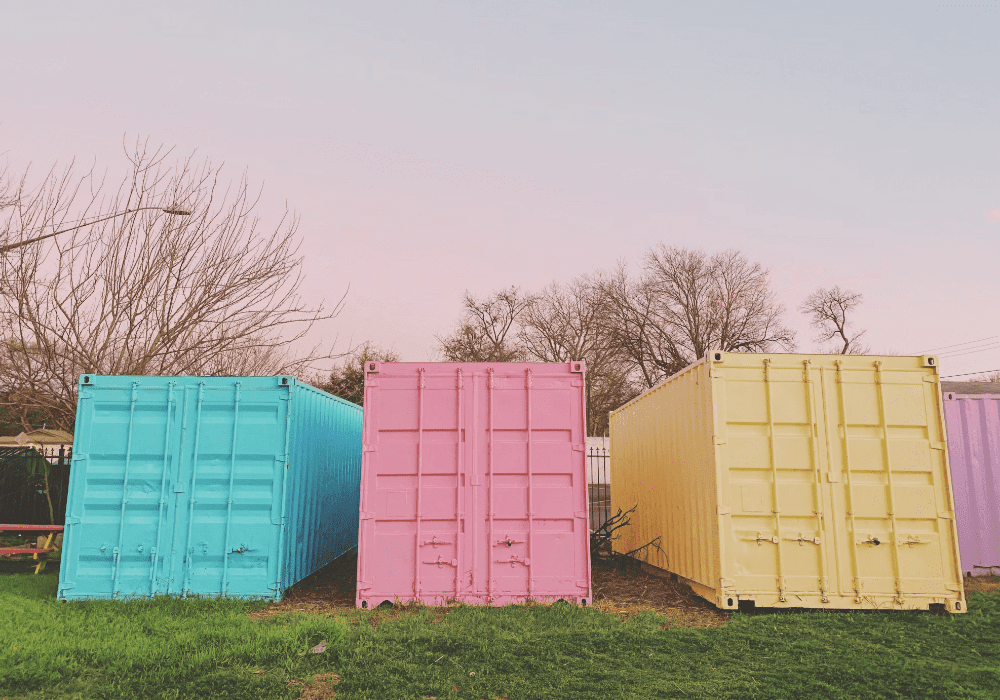
Shipping containers come in a wide variety of types and sizes– including different lengths, different heights, different door configurations, and any of several possible features or customizations that can be added on. One shipping container doesn’t fit all needs.
Fortunately, when browsing online, you can find several different types. Evaluate your specific needs in order to decide what kind of container will work best for you. Here are some tips:
Start By Choosing the Length
It may seem a little strange to start your shipping container journey by trying to figure out how long you need your container to be, but this really is one of the most important things to consider. Unless you have a warehouse that you plan on using to store your shipping containers, chances are you’ll be keeping them outside– and that means that they have to fit into the amount of space you have available for them.
In order to make sure that you’ll have enough space to actually keep your storage container, it’s important to have an understanding of how long and how wide of an area you’re working with.
In terms of container width, most shipping containers are 8′ wide. This means that, as long as the width of the site where you want to put your container is greater than 8’, you’ll probably be able to fit it just fine.
The real thing to consider in terms of shipping container size is its length. Containers can come in several different lengths, depending on your needs and how much space you have to work with:
10’ Shipping Containers

If you don’t have a large amount of space outside to put your shipping container, a 10’ container might be a great solution for you. Since these containers are 10’ long by 8’ wide, they fit easily into most outside spaces, making them great options for those who don’t have much space to work with.
Even better, in spite of their deceptively small size, 10’ shipping containers offer you quite a bit of storage space– 563 cubic feet, to be exact. This size is comparable to a small shed, to give you some context– the main difference is that it may be easier to take full advantage of vertical storage space in a 10’ shipping container than in your shed.
10’ shipping containers are less common than their 20’ and 40’ counterparts, and this is usually because they are made out of 20’ containers divided in two. As a result, they often have a higher price in relation to their size than most other shipping containers– this can still be worth it, though, if you really need the space and have a limited area in which to place a container.
20’ Shipping Containers

If you need more space than a 10’ shipping container provides, don’t worry! 20’ containers are a very common size to see. They still fit relatively easily into most outdoor spaces, too, so they’re convenient.
With such an easy-to-accommodate size, 20’ containers are used for a wide variety of things– besides storage and shipping, they can be converted into garages, sheds, offices, and more. They’re even used for living spaces sometimes– a 20’ container offers you about as much space as a one or two bedroom apartment, and those who are fans of the tiny home movement have definitely caught on to this. These containers are also often found on construction sites as temporary offices or in the retail and food industries as extra storage space.
40’ Shipping Containers

Is a 20’ shipping container still not quite enough space for you? No worries, because you can find an even bigger container to suit your needs just fine. 40’ shipping containers require a larger resting site than 20’ and 10’ containers, but they’re still generally easy to find space for.
Besides that, they offer a lot of storage space. 40’ containers are about the size of a two or three bedroom apartment or a two-car garage, and they offer a solid 2,350 cubic feet of storage space. This makes these containers ideal for heavy tool and equipment storage, keeping a large inventory in the retail and food industries, and the small home movement. With such a wide variety of uses, it’s no surprise that 40’ shipping containers are about as popular as their 20’ counterparts.
Next, Choose the Height
Besides coming in a variety of different lengths, shipping containers can also come in different heights. If you’re in need of considerable vertical storage space as well as horizontal storage space, the height of your shipping container is definitely something to take into account.
Standard Shipping Containers

For most purposes, standard shipping containers more than do the trick in terms of height. Standard-sized shipping containers are 8.5’ tall across the board– usually tall enough to fit shelves and plenty of supplies or inventory.
High-Cube Shipping Containers

As we mentioned, standard shipping containers do just fine to fit most people’s storage needs. However, if you’re looking for more vertical storage space or need to store items that won’t fit in an 8.5’ tall container, high-cube containers are always an option.
High-cube containers provide an extra foot of vertical storage space, measuring 9.5’ tall. In terms of storage volume, that can give you a lot of extra space– anywhere from just 80 more cubic feet for a 10’ high-cube container to a full 320 more cubic feet of space on a 40’ high-cube container.
Think About Door Configurations
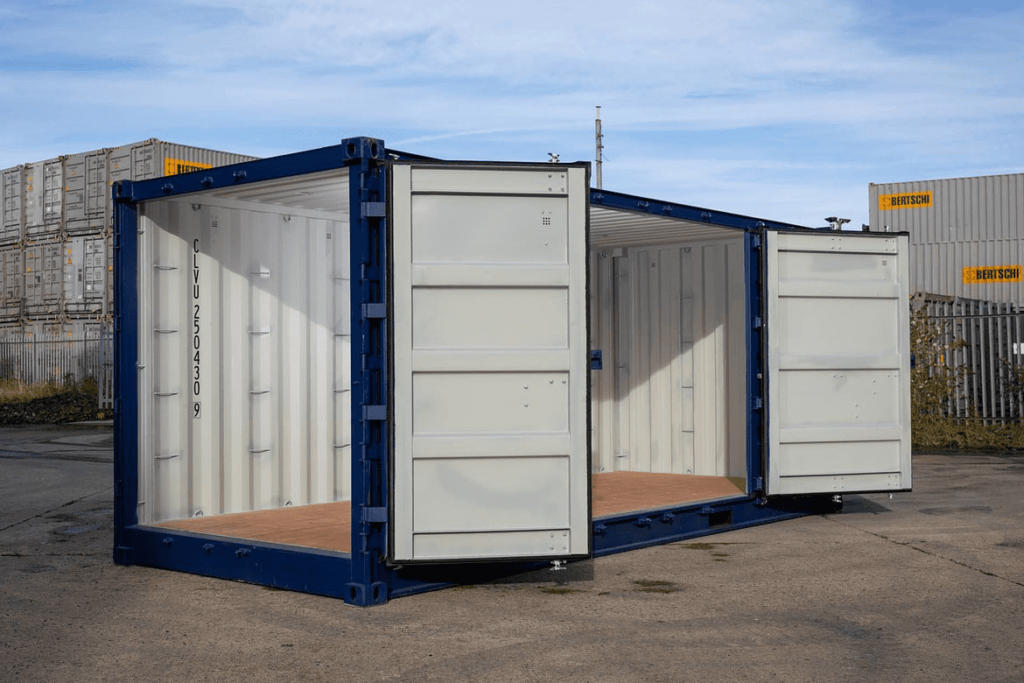
It may not occur to you at first to consider what kind of doors you want your shipping container to have. But similar to evaluating your container’s length and height, you’ll definitely want to consider where its doors are and how they open. In order to figure out what kind of door configuration you’ll need, try thinking about what you’re going to use your shipping container for.
Here are the types of door configurations that you can find:
- Standard doors
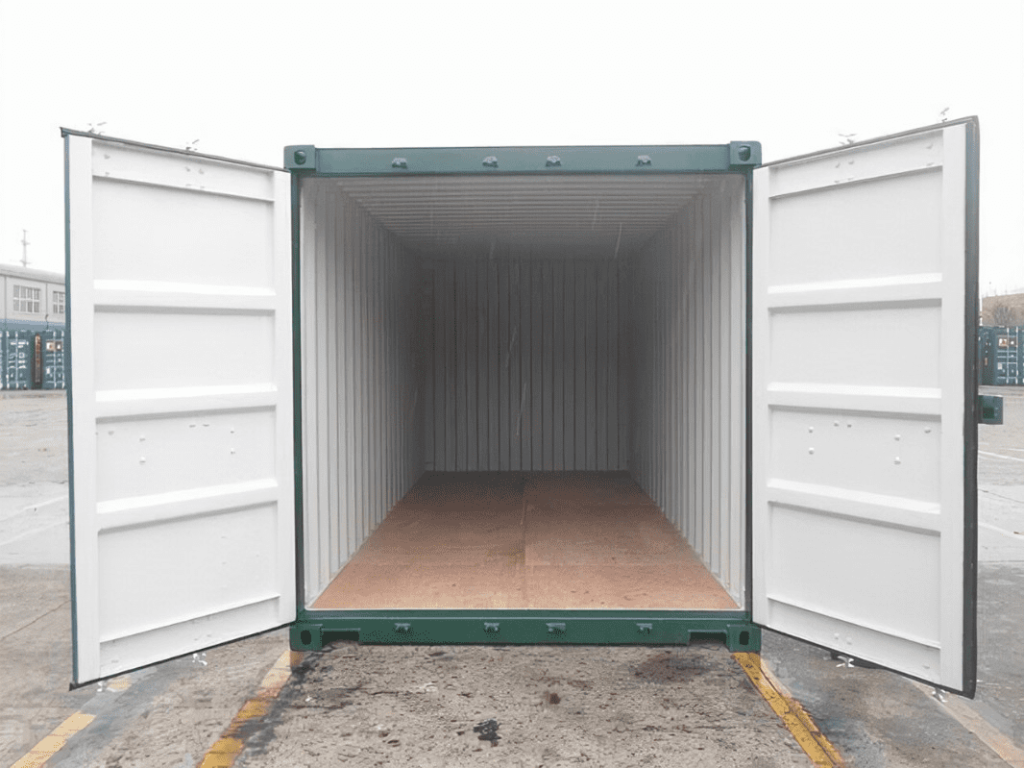
Standard containers will usually have one set of double cargo doors on one short end of the container. These are by far the most common option, and they are available on both used and new containers. Standard doors are solid options if you just need to load and unload cargo.
- Double doors

If a standard door container will not work for you, there are also double door containers available for purchase. These come with cargo doors on both short ends of the container. Double door containers are super useful if you need quick access to both ends of your shipping container at a moment’s notice– there will be no digging through 20’ of stored items in order to grab something from the very back.
- Open-side doors
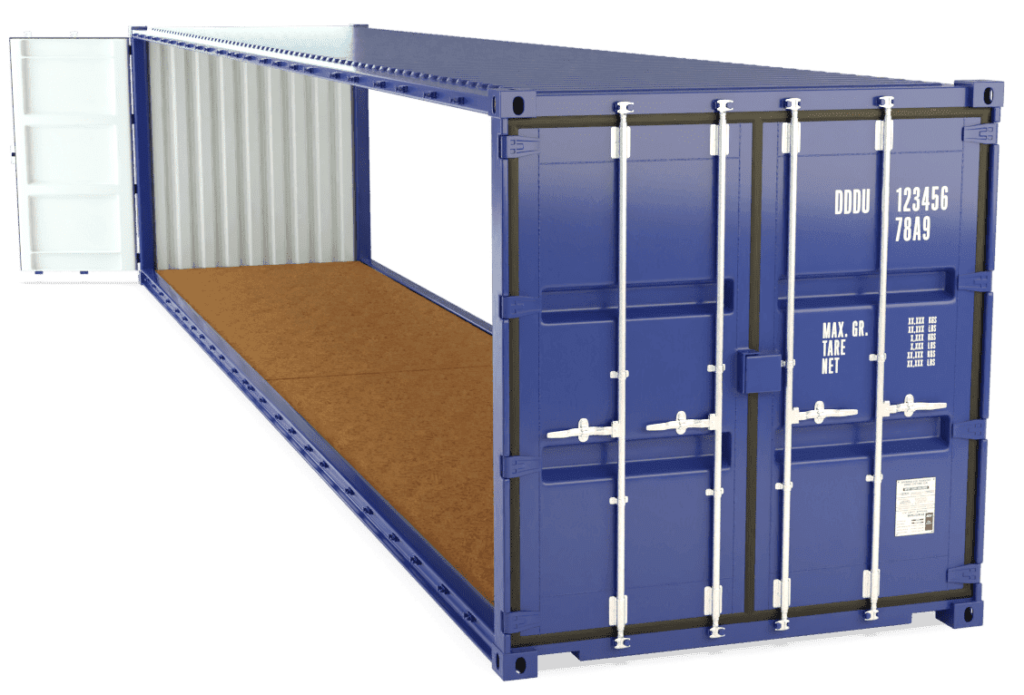
Open-side containers have a long door along one of the sides of the shipping container. If you’re storing large items or need to be able to quickly shift around your stored items without removing them from the container altogether, an open-side container might prove extremely useful– it’ll take less difficult maneuvering to reach what you need. Open-side containers are also popular door configurations for people trying to build a shipping container office or living space, because they give you the option of opening the doors to create a sheltered, yet open, space.
Consider What Container Condition You Need
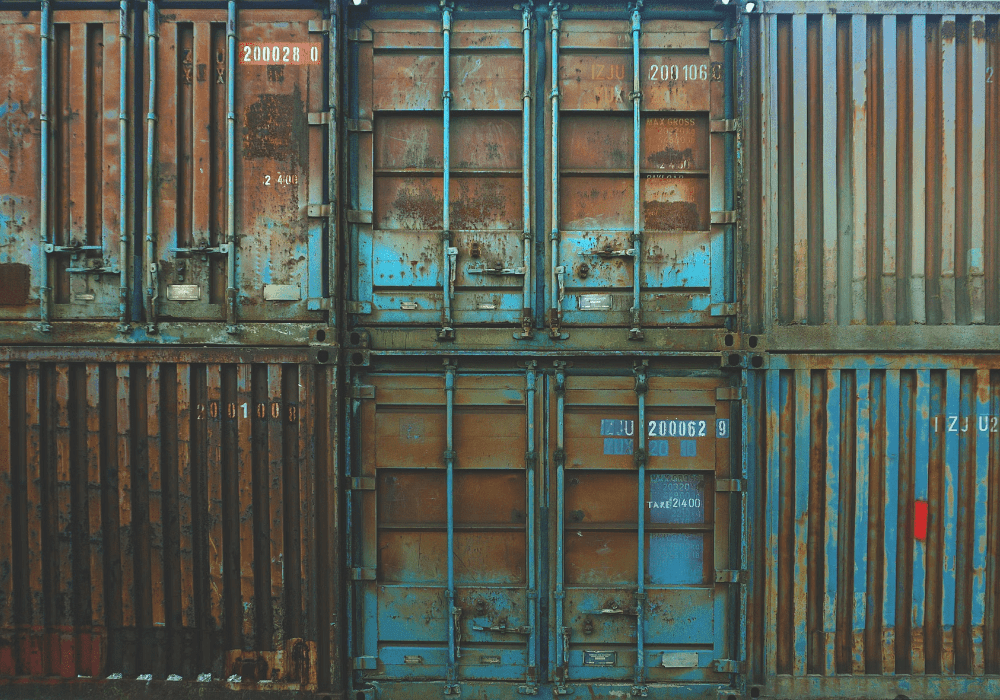
Now that you know what size of container you need and what door configuration will work best for you, it’s time to start narrowing down your options and decide what condition you need your shipping container to be in. On the surface, shipping containers can be broken down into two major categories: new and used. But the analysis doesn’t stop there– there are several different conditions within those two categories to consider.
Used Containers

Used shipping containers can be significantly less expensive than their newer counterparts. Used containers have been through previous use– for long-term storage or for freight overseas, for example. As such, they’ll definitely come with some minor dings, dents, and/or surface rust. However, depending on your budget and your needs for your shipping container, used containers can still definitely be worth the purchase. At Rent-A-Container, used shipping containers can cost anywhere from around $2,000 up to $7,500.
There are several types of used shipping containers: As-Is, Cargo Worthy, Wind and Watertight, and IICL.
As-Is Containers

As-is shipping containers are generally the least durable containers you can buy. These containers have usually already had a long life and been heavily used for either cargo or long-term storage. They frequently have rusted walls or floors, non-functioning doors, or structural issues that prevent them from being used in most instances– and these are problems that you’ll need to be prepared to handle if you purchase one.
They are, however, much cheaper than their newer counterparts– often anywhere from a couple hundred dollars up to a couple thousand. And if you’re particularly creative or handy enough to repair them on your own, containers purchased as-is can often still be converted into sheds or offices. These containers take some patience and skill to work with, but they might still be useful to you.
Cargo Worthy Containers
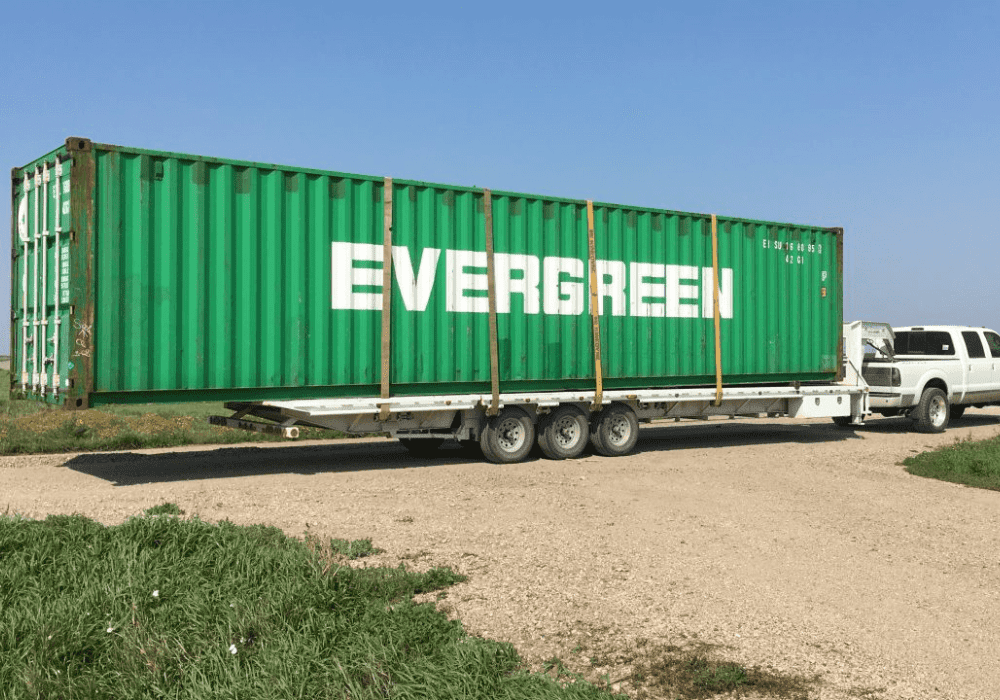
Cargo worthy containers are one of the most common options for used shipping containers. These containers have generally been inspected and deemed durable enough to handle shipping goods over land or sea– so if you’re looking for a shipping container for purposes of transportation, this might be the way to go.
Keep in mind, though, that just because cargo worthy containers have been inspected at some point does not necessarily mean that their inspections are up-to-date. If you purchase one of these containers in order to ship goods, you’ll definitely want to make sure that its CSC plates are up-to-date and valid and that it has any documentation needed in order to be shipped internationally.
Wind and Watertight Containers

Wind and watertight shipping containers may look pretty much the same as cargo worthy containers, but they are usually just a bit less durable. Most wind and watertight containers are older containers that are still in decent condition but can no longer pass CSC inspections and are no longer suitable for long travel. They will, however, keep wind and water out of the container and off of your belongings, which makes them perfectly fine options for on-site storage, shed space, or even office space with some modifications.
IICL

If you know that your shipping container, used or otherwise, is going to go through some heavy use, it may be worth looking into an IICL-approved container. The IICL, or Institute of International Container Lessors, has a specific and detailed grading process by which they approve and grade used shipping containers for storage and shipping purposes. As a result, IICL shipping containers are generally in the best condition out of all used shipping containers.
New Containers

Shipping containers that have either never been used before or have only been on one cargo shipment are considered new. New and one-trip containers will be in excellent shape overall, have a newer and solid paint job, and will usually not have large logos painted onto the sides. For customer-facing facilities, storage sheds, or offices, new containers are popular options.
Buying vs. Renting — When Should You Buy Shipping Containers?
Learning how to buy a shipping container is only half of the battle. Deciding whether you should rent or buy shipping containers can be just as difficult as narrowing down what type of container you need. You want what is best for your business and wallet. And in many cases, that means you should purchase a container.
Ask yourself these questions to determine whether you should rent or buy your storage container:
- How often do you intend to use the shipping container?
Will you need a container for a year or longer? If so, buying it is likely a wise choice. You will save money in the long run by purchasing instead of renting it. However, if you need extra storage for seasonal use or temporary jobs, there is no better solution than a rental.
- Do you want the freedom of ownership that comes with buying a container?
Ownership has its privileges, such as the ability to modify the container. Rented containers are generally required to stay in the same location. But you can take a container you own anywhere you like. And owning the container affords you the benefit of being able to sell it later without any of the design or modification restrictions of renting.
- Do you need to store hazardous materials in your shipping container?
Renting a storage container provides huge flexibility, but one spot where you may feel somewhat restricted is in what you can store. You can store most items inside rented containers, but many shipping container rental companies place restrictions on hazardous materials, such as volatile chemicals. If you need to store items like this, buying a shipping container is probably the way to go.
- Do you have a way to transport your shipping container?
When you own a shipping container, it’s yours for as long as it lasts. If you intend to place the container in a spot and let it sit there for years, that’s no problem. But if you frequently need to move the container, you need to be sure you have access to the right equipment to do so. If moving the container is going to present a big challenge, you might want to consider renting containers for shorter periods and having them delivered directly to your worksite.
Interested in renting a shipping container? Check out our Container Rental Guide.
Common Uses for Shipping and Storage Containers
The question of what you plan to use your container for is just as important as the question of how to buy a shipping container. Different industries and individuals rely on shipping containers for storage and container offices. But the uses for storage containers are nearly limitless.
Buy Storage Containers for Industry Use

Because shipping containers can be modified, they work for almost all industries. Construction might be the most common, but these containers are popping up just about anywhere you can imagine. These industries include the following:
- Construction
- Manufacturing
- Education
- Automotive
- Retail
- Agriculture/farming
- Healthcare
- Residential storage
Buy Shipping Containers for Container Homes and Businesses

Contemporary building designers all over the world are refurbishing shipping containers into everything from small, affordable living spaces to large buildings, restaurants and coffee shops– you name it, it exists. All of these designs look sleek and modern, maximize space usage, and have environmental benefits by cutting down on the damage and pollution caused by traditional building construction.
What You Should Know Before Ordering a Shipping Container
Learning how to buy a shipping container is easy with Rent-A-Container. The following information can make it even easier:
Find the Best Shipping Container Price
When you research how to buy a shipping container, you’ll be surprised by how widely prices can vary. At Rent-A-Container, we guarantee the lowest price on your shipping container. We shop city by city and state by state to ensure we are finding the best prices across the country, saving your wallet in the process.
With our access to tens of thousands of containers, we can find exactly what you need at a great price. If you find a lower shipping container price somewhere else, just let us know. We will beat it!
Consider the Shipping Container Delivery Method

Used shipping containers for sale are normally delivered on roll-off trailers. However, you can also pick up your shipping container. If you use a website that allows you to compare shipping container prices, you can factor in the cost of delivery, as well. Remember, if you find used shipping containers for sale close to your home, the delivery cost will be lower.
Generally, 40-foot containers are delivered on a 40+ foot trailer pulled behind a truck. This can be a pickup truck or a day-cab/semi. At Rent-A-Container, we will work with you to ensure that the truck delivering the container is the best choice for the delivery site.
By contrast, 20-foot containers are typically delivered on a tilt-bed tow truck (what they use to tow vehicles with four-wheel drive). These trucks are more maneuverable and have a smaller turning radius, allowing them to deliver the containers to tighter spots.
Prepare the Location for Shipping Container Placement

After you have learned how to buy a shipping container that fits your needs, you must prepare for the delivery and placement of the container. The trucks that deliver shipping containers can weigh up to 45,000 pounds, so they require a hard surface. If the drivers attempt to maneuver through wet grass or mud, they can get stuck. This results in added costs and hassle.
Learn more about site preparation in our Shipping Container Site Preparation Guide.
Avoid Water
When considering where your container will sit, the most important factor is avoiding a location where water can pool at the base of the container. You can use railroad ties or some other moveable foundation beneath the container to avoid water buildup. You can also lay gravel or another base that will drain water easily.
Get Help
If you do decide to use railroad ties, you should ensure that you have someone there to move them during delivery. While the delivery driver may be able to help, you should not assume that they will be able to move them for you.
Clear the Way
Finally, make sure the delivery site and path through the property are free and clear of debris to save time and energy on the day of delivery.
Ensure You Have the Necessary Clearance
Shipping container delivery trucks also need ample space at your delivery site to maneuver. Assume that you will need the following:
- A minimum of 100 feet of straight clearance for 40-foot containers and 60 feet of straight clearance for a 20-foot container (Measure the space from where the back of the container will sit)
- A minimum of 12 feet total width for the truck to deliver the container
- A minimum of 14 feet of vertical clearance for the truck and container to drive under an obstacle safely
- A minimum of 20 feet of vertical clearance at the actual delivery site in order to safely complete the tilt-off delivery
How to Buy a Shipping Container: Team Up with Rent-A-Container
Now you have the information you need to take the next steps. Browse the Rent-A-Container website and buy storage containers today! If you find a similar shipping container in your area for a better price, take advantage of our price match guarantee to make sure you get the best deal possible.
Rent-A-Container’s online store makes buying a shipping container easy. Our three-step process is as simple as:
- Place your order online.
- Check out.
- Sit back and relax.
If you have more questions about how to buy a shipping container, please check out our blog and Frequently Asked Questions or contact us directly!
